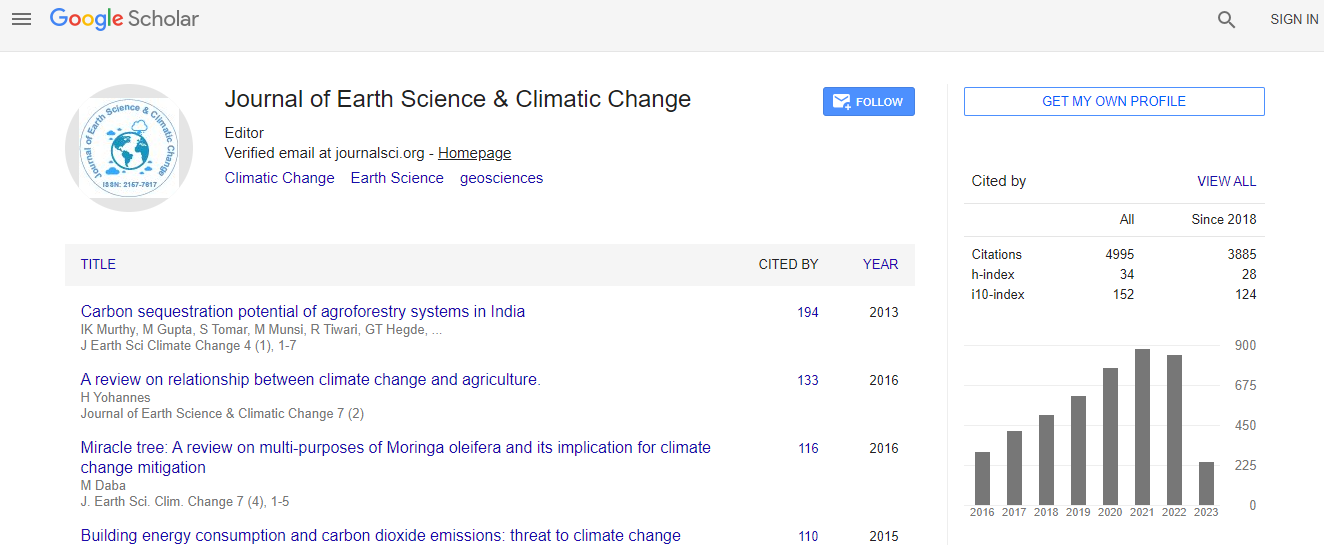Our Group organises 3000+ Global Conferenceseries Events every year across USA, Europe & Asia with support from 1000 more scientific Societies and Publishes 700+ Open Access Journals which contains over 50000 eminent personalities, reputed scientists as editorial board members.
Open Access Journals gaining more Readers and Citations
700 Journals and 15,000,000 Readers Each Journal is getting 25,000+ Readers
Google Scholar citation report
Citations : 5125
Journal of Earth Science & Climatic Change received 5125 citations as per Google Scholar report
Journal of Earth Science & Climatic Change peer review process verified at publons
Indexed In
- CAS Source Index (CASSI)
- Index Copernicus
- Google Scholar
- Sherpa Romeo
- Online Access to Research in the Environment (OARE)
- Open J Gate
- Genamics JournalSeek
- JournalTOCs
- Ulrich's Periodicals Directory
- Access to Global Online Research in Agriculture (AGORA)
- Centre for Agriculture and Biosciences International (CABI)
- RefSeek
- Hamdard University
- EBSCO A-Z
- OCLC- WorldCat
- Proquest Summons
- SWB online catalog
- Publons
- Euro Pub
- ICMJE
Useful Links
Recommended Journals
Related Subjects
Share This Page
In Association with

Craterlets and seismites in a siliciclastic tidal flat (northern Kuwait): Implications for fluid flow in the Persian Gulf (Arabian Gulf)
5th International Conference on Earth Science & Climate Change
Michael J Duane
Kuwait University, Kuwait
Posters & Accepted Abstracts: J Earth Sci Clim Change
Abstract
The first interpretative field map and geochemistry of exhumed conical mud volcanoes in a Persian Gulf salt flat are reported. The siliciclastic low heat flow margin of the northern Arabian Gulf (Kuwait) produced sedimentary conditions with numerous multilayered, unstable density gradients that were highly susceptible to recording liquefaction effects. The geotechnical conditions of a sabkha and the effects of local seismic activity were ideal in the marginal sediments in Kuwait Bay and well-suited for the development of deformation features. Three-dimensional, pseudo-biohermal exposures exhibit ellipsoidal pillows with craters separated by fluidized channels forming a chaotic orientation. The size and morphology of these structures together with cogenetic mud volcanoes is strongly influenced by sedimentary factors such as density gradients, tectonic events such as localized seismic activity and geochemistry of the fluids. Diapirs emerged in coincidence with syn-sedimentary deformation and the mud remobilization responded to episodic seismic activity. These structures represent new abiotic sedimentary features in sabkhas but the per-ascensum nature of the fluid offers comparisons to siliceous hot-water vents in southeastern Brazil.Biography
Email: phytokarst@gmail.com

 Spanish
Spanish  Chinese
Chinese  Russian
Russian  German
German  French
French  Japanese
Japanese  Portuguese
Portuguese  Hindi
Hindi 
